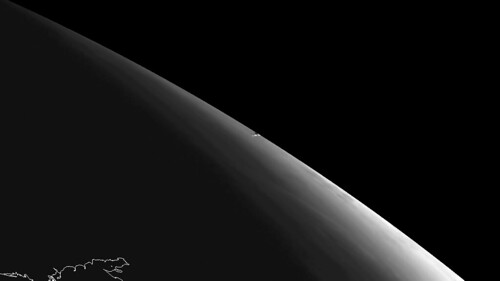A meteor (or bolide, the term for a bright, exploding fireball) exploded in the sky over Russia, with a bright flash of light and multiple loud bangs seen and heard in Chelyabinsk in the Ural Mountains. The shockwave injured people and caused light damage to structures in the city. Since dashboard cameras are so prevalent in Russia, many drivers caught the early morning fireball:
This is one of my favorites, as the split screen lets you see both the meteor and the driver’s reaction:
Rumors are flying in the early hours after the incident, but there’s some comprehensive photo and video aggregation of the fireball and its aftermath on Say26, RMNB, Zyalt LJ (some funny images towards the end of that latter post). Take with grains of salt all around. The Russian hashtag челябинск is also interesting (and occasionally hilarious) to watch.
Phil Plait (aka Bad Astronomer) has some preliminary analysis, with more media, including these clips with the sound of the explosion, and the shattering glass that followed:
Multiple sources mention that this building was a zinc factory (?) in Chelyabinsk that was struck by meteorite fragments, but I’m skeptical, seeing as how the trail went over the city. I find it more likely that the building was damaged in a fire related to the shockwave:
Photos going around purporting to be the meteorite impact crater are actually a natural gas fire pit in Darvaza.
ESA satellite EUTEMSAT captured a view of the meteor’s vapor trail and thermal impact from orbit:
More on the fireball from Alan Boyle’s Cosmiclog on NBC News.
Coincidentally, this comes the night before Asteroid 2012 DA14 swings close by Earth, just 17,200 miles from the surface — closer than the moon and geosynchronous satellites. There’s a temptation to think of a certain asteroid movie, but this meteorite is probably an unrelated coincidence. 2012 DA14 is approaching from a complete other direction: south, and this meteor was in the northern hemisphere.
Updates:
NASA JPL analysis of the meteorite showed this was unrelated to the 2012 DA14 asteroid flyby. (Simply explained with this graphic from Alice’s Astro Info) The meteorite had an estimated size of 17 meters, mass of 7,000 to 10,000 tons, and its primary explosion in the atmosphere had an equivalent yield of about 500 kilotons.
(I was skeptical about the 500 kt energy release estimate, seeing as how the Ivy King air-detonated nuclear test was of similar yield, but Chip Legett set me right with a reminder that the explosion was much higher in the atmosphere than the Ivy King blast, and exploding meteors release energy in a different way from nuclear devices.)
@brownpau @vnangia @ageekmom 500kt is very reasonable. Remember inverse square law. I.king was near surface, not 30kft @ burst (cont.)
— Chip Legett (@ouemt) February 17, 2013
@brownpau @brownpau @ageekmom peer review ref for impact effects: impact.ese.ic.ac.uk/ImpactEffects/ Also not as hot as a nuke energy released different
— Chip Legett (@ouemt) February 17, 2013
On Meteors and Megatons — more from Nuclear Secrecy on the problems with measuring meteorite impact events in terms of nuclear weapons yield equivalents.
The object may be called “The Chebarkul Meteorite,” after the lake where meteorite fragments were found. Based on the composition of the fragments, the meteorite was most likely an ordinary chondrite, stony with low iron content.
After the meteor, some in Chelyabinsk prepare to clean up — Washington Post story on the aftermath and recovery.
From two weeks later, Additional Details on the Large Fireball Event over Russia on Feb. 15, 2013. The word “superbolide” is used. Approximate total impact energy was estimated at 440 kt, with qualifications about the difference between that and radiated energy. Based on composition and orbit the fireball was definitely not associated with 2012 DA14.
